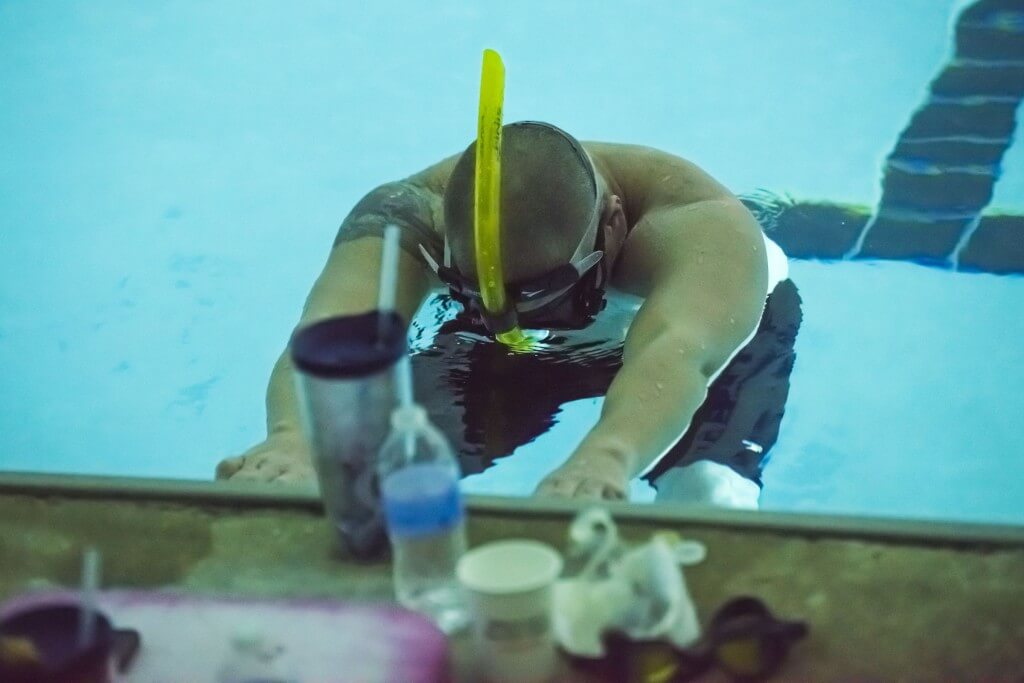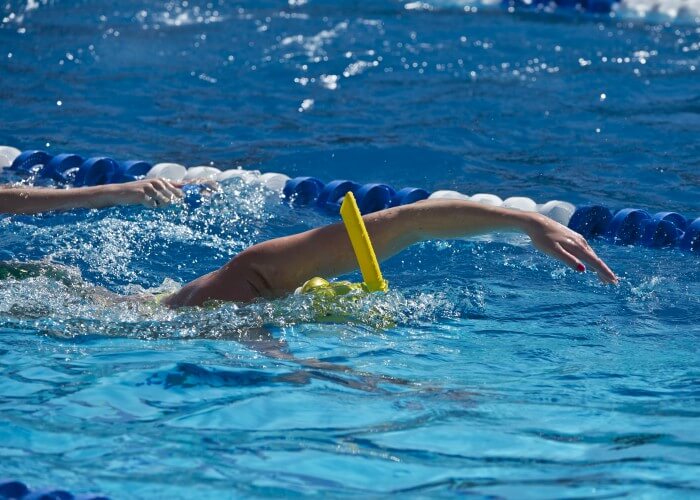10 Swimming Gear Concepts To Get You Swimming Fast

By Wayne Goldsmith
When you start training and your mind turns to thoughts of swimming fast, inevitably you will notice the incredible range of training toys and tools and the abundance of gimmicks, gadgets and gizmos, all designed to help you realise your swimming performance goals sooner and easier.
Swimmers are some of the most technologically literate athletes in the world and most swimmers will readily embrace any piece of training equipment which can potentially make a positive impact on their training program.
A quick Google of “swimming training equipment” or “swimming training aids” will get you more websites than you’d usually find when searching for “fast food” or “football results” and there are literally hundreds of swimming training equipment manufacturing companies and sporting equipment retailers offering everything from paddles to pull buoys.
The challenge is deciding what piece of swimming training equipment is right for you.
Why use swimming training equipment?
There are three main reasons why a swimmer might include the use of swimming training equipment in their training program: Stroke development; Stroke correction and / or Stroke improvement / enhancement, i.e.
- To develop a specific aspect of their swimming technique (teaching a swimmer the fundamentals of stroke technique from the beginning);
- To correct a specific stroke technique error or a deficiency in their stroke mechanics;
- To improve and enhance a specific aspect of stroke technique.
10 Important Swimming Training Equipment Concepts:
- Training equipment is meant to enhance and improve a specific aspect of your swimming. Select swimming training equipment which can give you an edge or improve your swimming skills and technique in a specific area, e.g. paddles for “feel”, fins for kick.
- Training equipment isn’t a miracle cure or a short cut to enhancing your swimming performance: they are a supplement to your swimming training in the same way that vitamins and minerals are supplements to a sensible, balanced, healthy, nutrition rich diet.
- Avoid the “bigger is better battle”. Larger paddles for example do not mean faster swimming. Bigger fins do not mean faster swimming. Select swimming training equipment which is appropriate to you and your own unique swimming training needs.
- Don’t be afraid to include swimming training equipment in every part of your swimming training program. For example, you might include swim fins in your “kick set” but you could also include them in your “main set” particularly if the primary aim of your main set is to maintain a specific swimming pace which you can’t maintain without the use of fins.
- Try adding one piece of swimming training equipment at a time. For example, using paddles, fins and some kind of resistance device like a “parachute” over-complicates your training and makes it difficult to determine what – if any – benefit you are getting from any one piece of training equipment.
- Talk to your coach about “why” you need to use swimming training equipment so you understand how it is improving the efficiency of your swimming stroke. Using swimming training equipment “just because that’s what we do” is not a good enough reason.
- Not all swimming training equipment is right for everyone. Some swimmers will benefit considerably from using paddles. Others will find that using swimming paddles will actually damage their stroke technique and decrease their swimming efficiency.
- Think 1:4 or more: that is for every lap of swimming that you complete using a piece of swimming training equipment, complete at least four laps without.
- Plan to gradually and progressively decrease your use of swimming training equipment as your swimming technique and skills improve. For example, it is common for swimmers to use swim fins often during the early years of their training to compensate for their limited kicking ability. However, over time as you improve your kicking skills, your kicking technique, leg strength and flexibility, it is less necessary to overly rely on swim fins.
- The bottom line is to select swimming training equipment that will improve the efficiency of your swimming stroke. Getting better at swimming up and down a pool with fins on in training is not the ultimate goal. Nor is becoming the best swimmer in the squad at using paddles. The aim is to develop a more efficient swimming stroke and a more effective swimming technique so you can race faster in competition.
Join the 4-H Club: What types of swimming training equipment are available?
There are hundreds of different swimming training aids available, but the ones that make a real impact on your swimming performance are those which directly involve your HANDS, your HEAD, your HIPS or your HEELS.
- Hands: Swim paddles are used by swimmers at all levels. Most swimmers and coaches believe that using swim paddles improves stroke power and swimming strength. However, the real benefit of using swim paddles is in improving “feel” – the ability of a swimmer to “hold on” to the water and apply pressure throughout their stroke. As a general rule, the LESS experienced a swimmer is, the SMALLER the swim paddle should be.
- Head: Goggles and cap are essential items in the kit bag of every swimmer. The bottom line with goggles and caps is to find a combination which is comfortable. There are some really amazing designs in the market and some swimming goggles that look like they’d be more at home in the cockpit of a jet fighter than on the head of an age group swimmer, but if they’re not comfortable to wear, don’t waste your money. Snorkels are also a valuable addition to your swimming kit-bag and are particularly useful when learning the importance of maintaining a strong, still and stable head position during swimming.
- Hips: Towing devices such as sponges and parachutes can help develop swimming strength by overloading arms and legs with additional resistance. The key to using any towing device is to make sure they sit “high in the water”, i.e. they can be used whilst the swimmer can maintain a “high hips” position when swimming. Anything you pull or tow through the water that “sinks” – to be frank – “stinks”.
- Heels: Fins and flippers are probably the most commonly used types of swimming training equipment. Fins come in all shapes, colours and sizes and many promise of range of benefits from increasing swimming speed to enhancing leg strength. The real benefit of using swim fins however is that they allow inexperienced swimmers to complete swimming drills effectively. As most swimming drills are completed at kicking speed, i.e. relying on the legs for the majority of propulsion, swim fins provide all swimmers with the opportunity to focus on their arms and their stroke technique and not be limited by their lack of kicking ability. Kickboards are perhaps the most widely used swimming training equipment and can be found in the swimming kit-bag of swimmers of all ages all over the world. The key to getting the most benefit from using kick-boards in training does not lie in the size or shape of the board itself – it’s how you hold – or rather don’t hold – the kickboard. (See an upcoming post specifically on this issue).

Photo Courtesy: Peter H.Bick
So, when it comes to swimming training equipment, think about the S.P.E.N.D.…..find swimming training equipment which:
- Will develop, correct or improve a SPECIFIC aspect of your swimming technique;
- Has a clear PURPOSE for its use;
- Will improve the EFFICIENCY and EFFECTIVENESS of your swimming stroke;
- Does NOT promise you unrealistic results with less actual swimming practice time;
- You can DECREASE its use over time as your swimming stroke improves.
Wayne Goldsmith





Val Garcia
Emerson Kirby
Brittany Archer
My kids coach uses this for his privates he has with them.
Regios Igcraa
Craig Politte